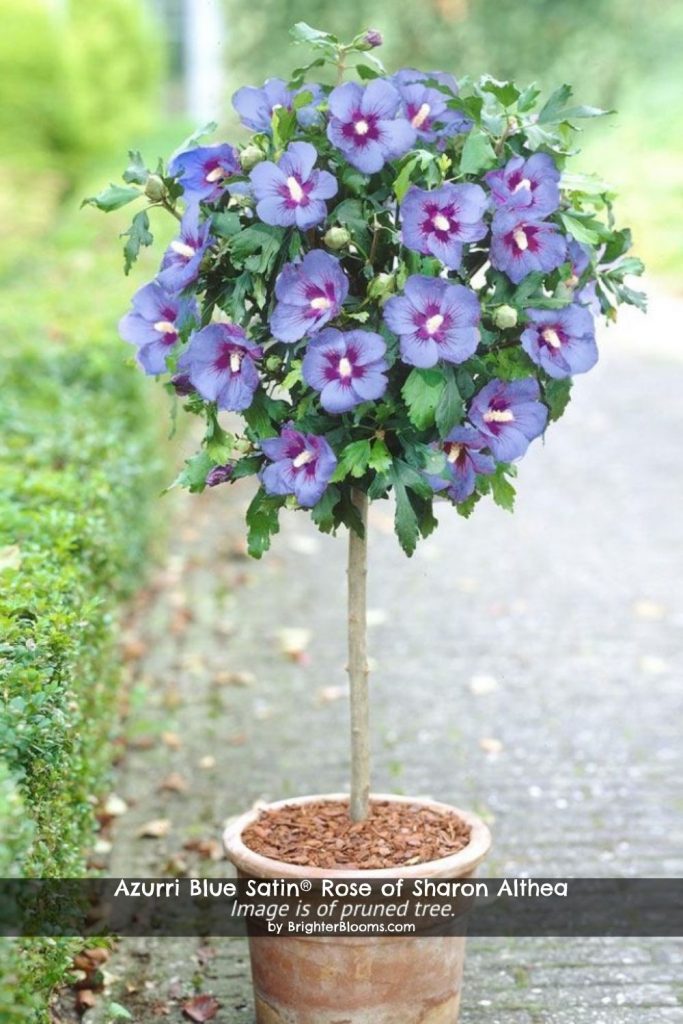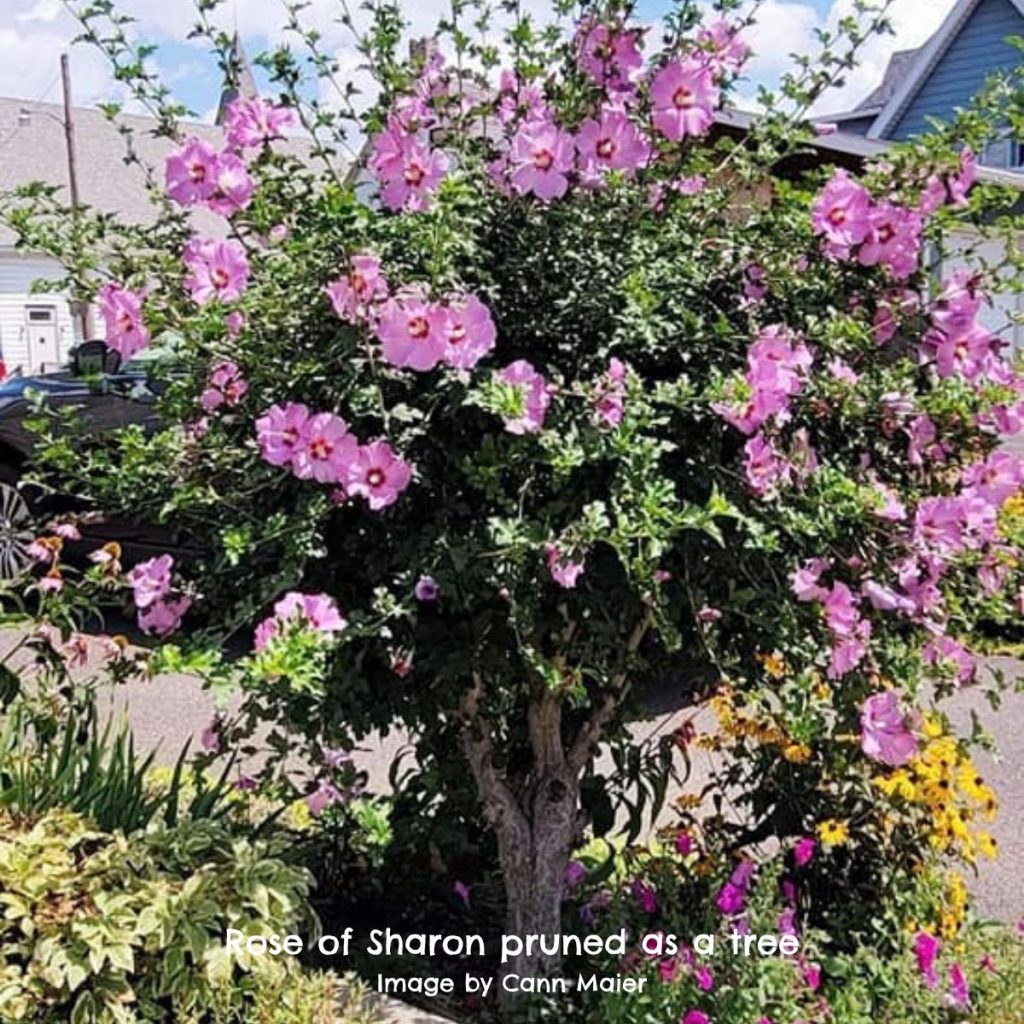Pruning your Rose of Sharon Plant is an important part of growing this fast-growing ornamental bush.
While many think of the Rose of Sharon as a shrub, it can actually grow into the size of small trees, and it doesn’t grow neat and tidily!
No… this prolific hibiscus in the Malvaceae family, kindred to marshmallow and okra, grows wily nily in all directions. So pruning a Rose of Sharon plant is essential for the best result in your landscape design. Otherwise it will grow wild and wooly and won’t hesitate to take over and rule its location.
Pruning helps maintain the overall health of the plants.
What is Rose of Sharon?
Rose of Sharon is a type of hibiscus, and goes by the scientific name of Hibiscus syriacus. This plant is a cold-hardy deciduous perennial that produces trumpet-shaped flowers of many colors and shades.
Rose of Sharon Hardiness Zones
H. syriacus does well in USDA hardiness zones 5-9. If you live outside of these USDA zones, you should choose another species of hibiscus, such as Hibiscus rosa sinensis.
These tropical varieties tend to fare better indoors in winter than the Rose of Sharon H. syriacus varieties. Just be sure it receives ample sunlight, such as through a southern facing window. Our Fiesta Hibiscus rosa sinensis did fine through the winter and even bloomed for a good portion of it.
Where we got into trouble with growing ours indoors is too much water. With the dryer heated indoor winter climate, the potted plants appeared dry in the top of the pot, o they would get watered. However, it was apparently more than they needed because leaves yellowed and started falling off.
You can read more about the signs and solutions for overwatered plants in this article on Meyer lemon leaves falling off.
Why to Prune a Rose of Sharon Plant?
We started this article by talking about the prolific growth that makes pruning Rose of Sharon essential for optimal beauty and plant health.
Pruning your Rose of Sharon will allow you to aesthetically shape it, encourage new growth, encourage more flowers to bloom, allow proper air-flow, and improve the overall health of your plant.
Pruning a rose of sharon plant also makes it easier to manage container-grown hibiscus. You can grow Rose of Sharon in pots outdoors where you’d also need to keep it to a manageable size. In pots indoors maybe doable but not advisable for this hardy growing bush, and reportedly not easily successful.
Aesthetics
Hibiscus syriacus plants are often purchased with the intention of beautifying landscapes. Hibiscus bushes that have uneven sunlight can grow unevenly, so pruning a Rose of Sharon plant helps it retain a more symmetrical bush shape.
Others enjoy pruning a Rose of Sharon to sculpt them into a vertically visual tree. For this effect, the lower weaker branches are pruned off to guide the plant into a tree trunk look. The upper bush is then pruned accordingly to your preference, tends to vary from o be in a perfectly round shape for added visual interest in a variety of landscape arrangements.

New Growth
Pruning a Rose of Sharon, when done correctly, will remove parts of the plant that are weaker and less productive. Some branches consume more nutrients and energy than they produce and are not helpful for the plant’s overall health.
This hibiscus plant produces plenty of growth in all directions, so removing spindly or crowded branches will improve appearance and health. Pruning will encourage the plant to grow by freeing up energy for roots and blossoms, and channeling it into the branches and trunks that craft the plant into a more pleasing shape and appearance
Improve Air Flow and Sunlight Exposure
Sometimes the more mature sections of the plant end up blocking the rest of the plant from receiving the essential fresh air circulation and direct sunshine that is needed. An example would be a a taller trunk that sprouted into multiple offshoots that are now creating a heavy umbrella of foliage and flowers at top.
If these older branches are inefficient at combating pests or diseases or converting sunshine into energy, it can be detrimental to plant. So removing the older, more crowded branches will improve the quality of life while also elevating the appearance of the shrub and subsequently, of your yard and garden landscape.
When to Prune A Rose Of Sharon Plant
Pruning your Rose of Sharon can take place in spring or fall. The exact period of these seasons will depend on the weather in your region. In general, it’s best to prune when the plant is dormant, such as early spring before buds form, or late fall after leaf drop.
Fall Pruning
Pruning a Rose of Sharon in the fall or winter (after the leaves have dropped) will result in more blooms for the plant during the following spring and summer.
Spring Pruning
Rose of Sharon flowers on new wood, which means that you can prune it in early spring before new buds appear. If pruned before spring growth commences, there will be no loss of blossoms.
If pruned in later spring, you may lose a few blooms but the remaining blossoms can grow stronger and bigger, so it may not be too late.
However, with spring pruning you tend to be racing against the clock, so for that reason, many prefer the certainty of fall pruning after leaf drop.
Rejuvenation Pruning a Rose of Sharon Plant
If you have an diseased, damaged, or spindly Rose of Sharon plant, you may want to do a rejuvenation prune, sometimes called a “hard” prune. Also called “cutting it back” or “whacking it to the ground”, a hard pruning is lopping off the plant about 6″-12″ inches from the ground.
This severe pruning forces the entire plant to completely regrow. By cutting away all competition for growth, the roots revive, grow and extract more nutrients from the soil for nourishing new growth.
Will the Plant Survive a Hard Prune?
Not always. You do run the risk of your plant not surviving a severe pruning, though most Rose of Sharons will tolerate this well. However, if your bush is ailing anyway, then it’s still the best option. If you lose it, it was meant to go and make room for something new and fresh.
If successful, the reward means a brand new plant that is much healthier and will grow strong and fast. If you choose to do a rejuvenation prune, you’ll need to do this in the fall after the dead leaves have fallen.

How to Prune A Rose Of Sharon Bush
General Pruning Tips
- SHARP: Use pair of pruning shears, loppers, or pruning saws. The cut should be clean, so make sure your tools are clean rust free, and sharp. Dull tools can rip or tearing the bark can and leave scars or long-term damage.
- STERILE: Sterilize your tools first with isopropyl alcohol. This helps prevent disease from spreading, especially if you plan to prune different trees, shrubs, or plants.
- ANGLED CUTS: Prune at a forty-five-degree angle. Making angled cuts keeps water from collecting and disease from forming.
- DRY WEATHER: Dry sunny days are best. Rain or snow can spread disease and leave your plants vulnerable.
- TRIM & ASSESS: During the process of pruning, make sure you step back after every few cuts to look at your plant. This makes it easier to keep your plant looking balanced and correct.
Pruning Tools
These are the pruning tools we use:
- Loppers – we just ordered this best rated lopper by Tabor, July 2022
- Pruners – see our favorite pruners and other tools article
- Pruning saw
In the pruning video at the end of this article, horticulturist, John Holden just uses a pruning saw. However we use all three of these tools, as well as a cordless pole saw especially for small tree limbing for branches we can’t reach safely with a ladder.

Step by Step Instructions for Pruning a Rose of Sharon Plant
- DEAD OR DAMAGED BRANCHES – Cut off any branches that look dead, partially dead, diseased, or otherwise damaged. Branches with scrapes, cuts, or deformities should be removed.
- VERTICAL GROWTH – Chop off branches and stems that are growing downwards or straight upwards (these are called water sprouts). Take out the oldest and tallest stems first. Suckers that are sprouting from the bottom of the trunk or roots should be pruned as well.
- BRANCHES THAT ARE:
- blocking sunshine from the rest of the plant
- crowded or crossed branches; you should be able to see individual branches of your plant. If it looks wild and difficult to differentiate between the individual branches, you should keep pruning. Aim for 8″-12″ in between the inner branches. This gives your plant the space it needs to produce many big and healthy blooms.
- inhibiting airflow
- leaning over with heavy foliage
- TRIM TO REDUCE SIZE, if needed. Sometimes your Rose of Sharon will simply grow too tall or wide for its space. It’s okay to trim off the ends of the stems or branches as needed. Be aware that this could encourage shoots to sprout from the old cuts, so you may need to pay attention to this and stay on top of pruning this new, undesired growth.
If you have hydrangeas, you may also enjoy this article on hydrangea pruning. If you’re also growing vegetables, you may enjoy this article on pruning squash plants.
You may also enjoy this article on rose of sharon names.
Contributions from the Community
15 Year Old Rose of Sharon Pruned Yearly
I prune her heavily every year. She isn’t very tall and is so pretty. About 15 years old now.
~Cann Maier

Informative Video on Pruning a Rose of Sharon Plant
This video by horticulturist, John W. Holden, of Land Designs Unlimited LLC, provides super helpful visuals of the steps outlined above for pruning a Rose of Sharon tree.
Rose of Sharon – Pruning from Bushes to Trees
Some of this video is a bit shaky, but you get to see a number of pruned Rose of Sharon bushes pruned like trees in this video by Tim Artson.
We are an online gardening publication sharing all things garden related! Including urban farming, family gardening, homesteading, gardening for profits, and more. We’re all about growth!

